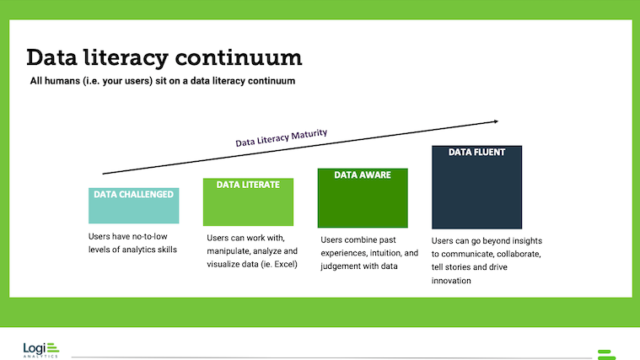Historically, businesses were top-down, executive-driven operations. The days of taking an executive’s instincts at face value however are long gone.
Today, successful businesses increasingly make data-driven decisions across the entire organization.
What’s standing in the way?
In the past, it was a lack of quality databases. But now, as more, better data is collected than ever before, a lack of numeracy, or the ability to understand and work with numbers, poses a challenge for businesses at large.
Studies have shown that application developers and businesses are overestimating the data literacy of their employees.
The 2021 State of Analytics: How Data Literacy Improves Decision Making report found these conflicting statistics:
- 84% of application teams think their end users have “high” or “very high” levels of data fluency
- 10% of users consider themselves data fluent
Going Beyond Data Collection
- Workers have become accustomed to utilizing applications in their personal lives to make decisions, purchases, and more. Applications like Amazon are successful because they understand the shape of the user’s decisions process.
- Meanwhile, at-work adoption of BI applications hovers around a mere 30%.
It’s time to close the data literacy gap
Charles Caldwell, VP Product at Logi Analytics, explained why it matters and how it impacts strategy succinctly in our recent podcast discussion.
“One of the biggest opportunities in application development is hacking the data literacy of your customers and their cognition. Solve the problem that augments the person.”
Charles Caldwell, VP Product, Logi Analytics
Context is Key
- Analytics are the key to making data-driven decisions. Simply having access to data is not enough. There is no value in providing users with a massive dataset without the context that an application’s analytics can provide.
- According to a recent report from Logi Analytics, 83 percent of business users seek the chance to work and stay in a single application when a decision must be made.
Users have an unmet and growing need for deeper interaction with their data.
- More contextualized insights can be gained when analytics are integrated directly into workflows. Embedded analytics in an application can help hack the way workers think by providing clarity and reducing confirmation biases.
When offering analytics to knowledge workers, it’s important to think deeply about the context in which users need analytics.
- When designing dashboards and data visualizations, always aim to create a cohesive user experience that not only gives users access to their data, but the context they need to make data-driven decisions.
Understanding Context Drives Increased Data Literacy
- By providing data in context, you reduce the time to action and enrich the user workflow, increase interactivity, and productivity.
- You also boost user comprehension of data when analytics are provided in a context they are already more familiar with.
This all leads to increased data literacy of your users and a virtuous circle of usage and engagement.
Boosting Data Culture
- Truly transforming a company’s data culture with BI begins by understanding the current data literacy levels of every user, and then investing time and resources to make realistic improvements.
- Achieving data fluency won’t happen overnight.
Organizations must make a concerted effort to:
- Boost analytics capabilities
- Increase access to data and analytics
Increased capabilities and access are the two important stepping-stones to reaching data fluency.
Understanding what the data literacy continuum is and where your customers are on it was the subject of a very lively sandwich shop themed breakout discussion at BoS Conf Online Fall this month.

A data-driven decision-making culture also demands more democratized data – the concept of data for everyone and every skill level.
- Decisions based primarily on gut instinct or opinion are too risky for today’s organizations.
- Applications have the power to combine data democratization with data literacy, so that a wide range of users can make decisions based on objective, verifiable information from the data they’ve collected.
- This directly connects an application’s analytics capabilities to a business’s successes.
To learn more about the state of data literacy today and how analytics are the key to transforming modern businesses, read further:
- 2021 State of Analytics: Why Users Demand Better
- 2021 State of Analytics: How Data Literacy Improves Decision Making
- Reaching Data Fluency: Finding the Right Path for Your Organization
- The Big Payoff of Application Analytics
Learn how great SaaS & software companies are run
We produce exceptional conferences & content that will help you build better products & companies.
Join our friendly list for event updates, ideas & inspiration.